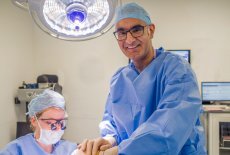Prominent Ear Correction (Pinnaplasty)
Who would benefit from this procedure?
Pinnaplasty is an ideal operation for those with prominent ears, poorly shaped ears or asymmetric ears. It sets back the ears, gives them a better shape and gets them as equal as possible. Mr Dheansa always ensures that the final result is as natural as possible.
How is it done?
Mr Dheansa's technique is as gentle as possible to avoid many of the problems associated with older techniques. He uses an incision behind the ear and then places sutures under the skin to adjust the shape and position of the ear cartilage to give a natural, set back ear. The skin is usually closed with dissolving stitches.
Pinnaplasty can be performed under local anaesthetic (just the ears are made numb) or general anaesthetic (you go to sleep). If you have a local anaesthetic then you can check to see how your ears look before the end of the operation.
Pinnaplasty is usually a day case procedure so you come in to hospital on the day of the operation and go home the same day.





What about bandages?
Mr Dheansa's technique means that you only need a tubigrip bandage (a thin elastic bandage) or similar to cover your ears overnight. During the day you don't need a dressing at all.
What happens before surgery?
Mr Dheansa will fully assess you for suitability at the consultation. It is important to discuss specific desires and outcomes before committing to surgery. Knowledge of general health will help assess fitness for anaesthetic. At the end of your consultation you should be clear about incisions, areas to be treated, length of stay and potential outcomes. If you are unclear about any aspect of your care or the procedure itself you must contact Mr Dheansa (contact details below) to clarify the situation before committing to surgery.
After the Surgery
What happens after the surgery?
Once you have recovered from the operation and been reviewed by Mr Dheansa you will be able to go home. You will have just a tubigrip bandage and some gauze behind your ears. You need to wear this overnight.
Mr Dheansa will normally see you a week after your operation. He will check your ears and make sure everything is healing well. He will normally see you two to three times after that to ensure that all is progressing well.
What should I expect post-op?
You should expect your ears to be numb after the operation. It will take a few weeks (sometimes months) for this to get as close to normal.
What can I do and not do at home?
Once you get home make sure you take some painkillers before you go to bed and put on your tubigrip bandage again. You need to wear your tubigrip at night for 4 weeks. Try to sleep as upright as possible for the first few days. The following morning you can remove the tubigrip bandage and the gauze behind your ears.
You can wash your hair as often as you would normally. However, it is best to avoid rubbing behind the ears for the first couple of weeks.
It is best to avoid sport and heavy activity for at least 2-4 weeks and any contact sport for at least 6 weeks. However most people can return to work or school within a few days providing there is no strenuous activity.
Once you are fully healed it is best to gently moisture the scar behind your ears 2-3 times a day to help them mature. At the same time it is best to moisturise the ears as a whole to help avoid any sensitivity developing. A simple moisturiser like E45 is ideal. Massaging and moisturising should continue for at least 6 weeks. Mr Dheansa will be able to advise on any other requirements.
Will my scars change?
All scars go through a maturing process and go through a series of changes before settling down. This process varies from person to person as well as from site to site on the same person. Generally once a wound has healed the scar will be a thin pale line. Over the ensuing 6-12 weeks the scar may become raised, pink and wider. It often becomes itchy too. It then stabilises before slowly becoming flatter, paler and less itchy. This can take up to a further 12 months. Even after this time scars continue to improve but at a much slower rate.
Avoid sunlight on the scar for the first year to avoid it getting burnt and then subsequently dark. It is very hard to make it pale again. Mr Dheansa will advise you of any further precautions or actions if required.
Follow up and after care
Mr Dheansa will normally see you a week after your operation. He will check your ears and make sure everything is healing well. He will normally see you 2-3 times after that to ensure that all is progressing well.
Things to Consider
It is important to be prepared before and after your surgery. Here are a few things to consider about this operation.
Expectations
As with any procedure it is important to have appropriate expectations. Your discussion with Mr Dheansa should give you a good idea of what to expect but rarely you may feel that your ears have been over or under corrected. It is important to have a clear idea of what you want before the surgery to avoid any disappointment.
Abnormal Scars
Sometimes even if all heals well a patient may develop abnormal scars (pink, wide, raised and itchy). Patients may already have noticed such a tendency from previous scars. Such scars take a very long time to settle (up to 18 months) if at all and may be difficult to treat.
Asymmetry
People are rarely exactly symmetrical and the intention of any surgery is to get both sides as equal as possible. However, the healing process is not always predictable and may result in differences from one side to the other.
Bruising and Swelling
Some patients may experience some bruising. This often results in increased swelling and some tenderness. The skin may become discoloured and take a few weeks to settle down.
Pain
Usually controlled with painkillers and again often resolves within a week or so.
Numbness
The treated area will lose sensation (feeling) after the operation and it will take several weeks for it to return. Some areas may remain numb.
Clots
Clots in the leg (DVT) lungs or chest infection are uncommon with this operation.
Sensitivity
This is most likely if the area is not regularly massaged and moisturised.
Are there any potential risks?
There are potential risks and complications with any operation and it is important to be aware of them before committing to any surgery. You may also have particular circumstances that affect the final outcome and these will be discussed with you at your consultation.
Anaesthetic
You will be assessed for fitness for anaesthetic and providing this is appropriate the risks from general anaesthetic are low. Anaesthetic can sometimes cause a reaction though this is very rare.
Bleeding
Rarely there may be significant bleeding under the skin that does not settle. Should this occur you may have to return to theatre to control the bleeding. This should not have any long term effect should it occur.
Sutures (Stitches)
Rarely one of the sutures holding the area together (under the skin) may give. This may require a further procedure to place a further suture.
Wound Infection
Wounds can very occasionally get infected. If you notice increasing redness, pain or an offensive odour from the wound, contact Mr Dheansa as soon as possible. If this should occur you will need to have antibiotics and frequent dressings. The wound may take longer to heal and the resulting scar may be less than perfect.
Dog Ears/Change in Contour
Some wounds can result in a slight dip in the middle if the tissues are not elastic enough. Dips tend to improve over time. Conversely the ends of a wound may have slight bumps (dog ears) which again usually settle but may require a minor procedure to correct.
Download Procedure Information
Download Consent Form
Frequently Asked Questions
How long is the operation?
About 60-90 minutes.
When can I shower?
Straight away as you will have a water resistant dressing.
How long should I keep taking pain killers?
You will often need pain killers for at least a week but everyone is different you may need to take them for longer.
When can I go to the gym?
You should avoid the gym until about 4 weeks after the operation but check with Mr Dheansa first.
How long until the final result?
It takes about 6 weeks for your ears to settle.
When can I fly?
Generally it is ok to fly 2-3 weeks after the surgery but this depends of length of flight and your recovery. Check with Mr Dheansa before flying.



